According to the official China Internet Network Information Center (CNNIC), in 2011 the number of Chinese Internet users grew to more than half a billion. It remains, however, a circumscribed and heavily censored space lacking such common global websites as Facebook and services such as Twitter. Some Chinese netizens sarcastically call China’s World Wide Web the ‘ChInternet’ or ‘China’s vast intranet’.
Despite this, the year 2011 may well have been a watershed. Government officials began reading Internet postings with a care once reserved for picking through editorials in the People’s Daily. The ability to decipher gnomic utterances in the Party newspaper was once vital to a political career; today, understanding the Internet is arguably even more important for Party and non-Party observers alike for the way it reflects China’s restive reality.
Great Firewall
(GFW; fanghuo qiang 防火墙)
The filtering system that blocks mainland Chinese Internet users from some international websites and web pages. Popular global websites restricted by the Great Firewall in 2011 included Facebook, Twitter and YouTube, as well the websites of various dissident groups and activists. Most Chinese Internet users simply write the English letters GFW when referring to the Great Firewall.
Jumping the Wall (fan qiang 翻墙) and Virtual Private Network (VPN)
Using virtual private networks (VPN), proxy servers or other technical tricks to bypass the Great Firewall so as to gain access to blocked websites is called ‘jumping the Wall’. A VPN works by encrypting the Internet traffic from a user’s computer and sending it to a server hosted abroad. The server connects with the global Internet and then encrypts the traffic again before sending it back to the user’s computer in China. Because the data is encrypted as it passes through the Great Firewall, it is not identified as objectionable and so the user can access blocked websites. Proxy servers and a few other technologies can serve the same function.
A High-speed Crash
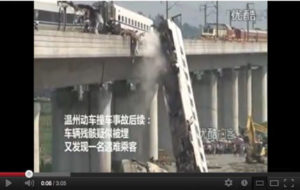
Screenshot of a video in which Internet users said they saw a body falling out of a carriage following the Wenzhou train disaster. This was after the authorities had announced a final death toll, and claimed that all bodies had been accounted for.
Source: Youku.com
Yangjuan Quanyang is the online moniker of a student at a Beijing university. She is one of the 250 million people who, in 2011, used Weibo, or microblogs, a Twitter-like service operated by the Internet company Sina. As Gloria Davies has noted in Chapter 5, in the People’s Republic of China, Twitter (like Facebook, YouTube, and many other near-universal websites) is inaccessible unless you use a Virtual Private Network (VPN) or other technical tricks to tunnel through the inter-meshed system of Internet roadblocks that is generally referred to as the ‘Great Firewall of China’.
Yangjuan Quanyang’s microblog page is decorated with cute cartoons. Until late July 2011, most of her tweets were about the mundane details of her daily life. On the evening of 23 July, however, she was travelling on one of China’s celebrated new high-speed trains, the D3115, speeding between Hangzhou and Fuzhou on the south-east littoral of the country. Just after 8:00pm, the train stalled near Wenzhou, a city famous for its entrepreneurs and the fabulous wealth they have amassed. As passengers sat waiting for an announcement about the delay, the D3115 was rear-ended by another train – the D301 – which was travelling along the same tracks also en route to Fuzhou, but from the direction of Beijing. The violent high-speed collision derailed six carriages. The D301 lost four carriages, including two that toppled some forty metres to the ground below from the viaduct on which the crash had occurred.
At 8:47pm, Yangjuan Quanyang tweeted:
Help! Train D301 is derailed just near South Wenzhou Station. Everywhere you can hear children crying. We can’t find the train crew. Please help us!
Yangjuan Quanyang’s tweet spread rapidly through the mainland and overseas media; it broke the news of the disaster. While most government journalists and information minders enjoyed their Saturday night as usual, news of the crash lit up the microblogosphere. In the early hours of the following morning, the Ministry of Railways in Beijing released a statement blaming the accident on a lightning strike. At 4:00am on Sunday morning, the state-owned Xinhua News Agency reported that the accident had resulted in thirty-five fatalities, and that all of the dead had been accounted for. But, at 5:00am, a toddler was found alive in one of the carriages. Later that same day, a bystander used a mobile phone to shoot video footage of derailed train carriages being pulled off the viaduct. The video contained a segment that showed what appeared to be a body falling out of one of the carriages. In footage uploaded by another Internet user, a small army of workers was shown burying two of the derailed carriages beneath the high-speed rail viaduct. Not long afterwards, the Ministry of Railways called a press conference and, when asked how the Ministry had found a toddler alive after issuing a statement that there were no more survivors, the official spokesperson Wang Yongping replied: ‘It’s a miracle!’
High-speed Rail
(gaojia tielu 高架铁路, or gaotie 高铁)
China’s first high-speed rail service, opened in 2004, was the Maglev train connecting Shanghai Pudong International Airport to the outskirts of the city. The Shanghai Maglev employed Japanese and German technology, but soon after Chinese companies began manufacturing everything needed for the construction of high-speed rail networks, from signal systems to seating. There is some debate as to how much of this ‘native’ technology was sourced via ‘unwitting technological transfer’. By the end of 2011, China’s high-speed rail network boasted:
- 9,676 kilometres of routes in service;
- an average speed of 200 km/h;
- more than 3,500 kilometres of rail lines with top speeds of 300 km/h; and,
- high-speed routes including Beijing-Shanghai, Shanghai-Hangzhou, Beijing-Tianjin and Guangzhou-Shenzhen.
Wang was asked if the Ministry was burying the train carriages to cover up evidence related to the fatal crash. He said that he had been told that the ground beneath the viaduct was marshy, and that the authorities had ordered workers to bury the carriages to provide a stable platform for rescue operations. Wang added inexplicably: ‘I don’t know if you believe it or not, I believe it!’ His statement was ridiculed on the Internet as an example of vacuous officialese and the avoidance of responsibility.
Over the next few days, as the Ministry of Railways changed their explanation, now blaming the accident on faulty signalling equipment, confusion reigned. One official even blamed foreign-made equipment for the collision, despite the Ministry’s previous proud boast that China’s high-speed trains were entirely kitted out with technology developed in China. In the week following the crash, over twenty million tweets about the incident circulated on China’s microblogs. Many were highly critical of the Ministry of Railways and its handling of the disaster. For a few days, the front pages of newspapers throughout China featured photos and stories about the accident and its causes. Even the most conservative of the state-owned media weighed in on the debate. Bai Yansong, a popular news anchor at CCTV (China Central Television, the state-owned national network), made highly critical comments about the accident. The People’s Daily, the official ‘mouthpiece of the Chinese Communist Party’, even published an editorial declaring that China should not strive for a ‘blood-stained GDP’. This was a reference to the rapid development of such things as high-speed rail, which throughout the 2000s had symbolized China’s relentless pursuit of GDP growth, often at the expense of the public good.
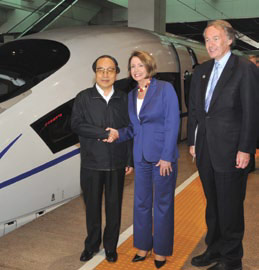
Former Railways Minister Liu Zhijun standing in front of a high-speed train with then Speaker of the US House of Representatives Nancy Pelosi and member of the House Ed Markey in 2009. Liu was sacked for corruption in January 2011.
Source: Wikimedia Commons
The grievances aired online and in the media that week had been simmering for some time. Earlier in the year, the government had sacked Liu Zhijun, the Minister of Railways for corruption. (Among other crimes and misdemeanours it was reported that he had kept eighteen mistresses.) More importantly, commentators expressed fears that Liu and his juniors had been skimming money from railway budgets by using cheap, inferior materials to build the new rail network, pocketing the difference to fund their lavish lifestyles. In June 2011, high-speed trains on the much-touted line between Beijing and Shanghai had experienced en route delays of many hours, leading angry passengers stuck in the trains with no air conditioning to vent their feelings – including via microblog.
The welter of complaints and outrage in the mainland media and Internet was, however, short lived. On 29 July, the organs of state responsible for propaganda and the media began clamping down, demanding that media and Internet companies reduce the coverage and criticism of the train accident. Consequently, the Wenzhou train wreck disappeared from the front pages of papers and Internet portals as quickly as it had appeared. For over a month it had been the number one trending topic on microblogs. It vanished completely (or, more accurately, was ‘harmonised’) from the list of hot topics literally overnight on 30 July. In the following days newspaper editorials appeared duly talking up the high-speed rail project. They declared as in a unified voice that while the Wenzhou accident was unfortunate, it was hardly a sign of a systemic problem.
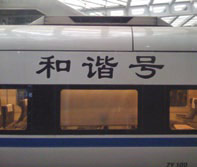
‘Harmony’, the name of all high-speed trains.
Photo: Geremie R Barmé
In tandem with this, a carefully orchestrated campaign was launched in the official media calling for an end to the publication of ‘unsubstantiated rumours’ in the blogosphere and on the Internet. The Party Secretary of Beijing pointedly visited Sina, the host-owner of China’s Weibo microblogs and his remarks on rumour control were widely reported. For its part, Sina sent messages to all of its Weibo users warning them that it would suspend the accounts of anyone guilty of spreading rumours and fomenting trouble. As part of the coordinated campaign, Xinhua New Agency released an article calling for an end to ‘poisonous rumours’ on the Weibo blogs, employing highly coloured political language that was reminiscent of the Cultural Revolution era (1964-1978) and the ‘anti-spiritual pollution’ campaign of 1983. Titled ‘To Eradicate the Poison of Internet Rumours, There Must be Much Stricter Punishments’ the article referred to ‘the worthless dregs of Internet rumours’, arguing that: ‘the Internet is an important vehicle for civilizing and improving society, but Internet rumours are like malignant tumours that harm the Internet and damage society.’
As the discussion was dampened down, the Ministry of Railways publicly issued instructions for high-speed trains to operate at slower speeds than had been originally announced. It was an indication of a lack of confidence in a system that only months earlier had been touted as symbolic of China’s unstoppable rise. Although the official death toll from the Wenzhou accident stood (finally) at thirty-nine, Chinese Internet users compiled a shared Google Document with details of killed passengers that indicate an actual death toll of forty-three. In August 2011, The New York Times reported this higher number without naming a source.
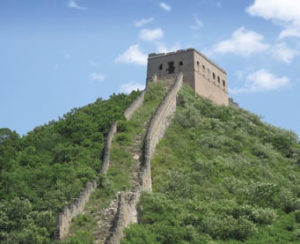
The Great Wall has become the most common metaphor for Chinese Internet censorship machinery, first called the Great Firewall of China in a 1997 Wired magazine article by Geremie R. Barmé and Sang Ye it is now often shortened to GFW by Chinese Internet users.
Photo: Danwei Media
There had been a brief window of media openness in the week following the crash. But the state’s censorship mechanisms kicked into gear quickly not only to silence calls for systemic change, but also in a way to stymie such change itself. People had little confidence that the real cause of the accident would be properly investigated – or that if there was an official investigation that its findings would be truthfully disclosed. Nor did there seem to be much possibility that the authorities would conduct a public investigation into the Ministry of Railways.
The Internet furore and the subsequent government clampdown illustrate the complexity of China’s networked reality. There are limits to what can be said online, and the state uses its vast resources of technology and human labour to ensure those limits are enforced. Nonetheless, the media and Internet users continue to shed light on the country’s problems and government malfeasances by blogging, tweeting and publishing online and in real time with a freedom that – if often circumscribed – was unthinkable before the advent of the Internet.
The Chinese party-state has been developing and refining its system of control and manipulation of the media and communications for over sixty years. From the earliest days of the People’s Republic, all print newspapers and magazines, radio and TV broadcasters, cinemas, and even printing factories were required to apply for and obtain various permits and licences to publish, broadcast or transmit information. Until the 1990s, only government and Party organizations could obtain such permits. But the system adapted itself admirably to the new guided, semi-market economy, allowing permits to operate media companies to be rented and/or purchased as part of a media investment. As ‘political errors’ can lead to permits being cancelled, private media operators have a strong commercial incentive to toe the line.
Microblog (weibo 微博)
Weibo is the Chinese translation of microblog. These are Twitter-like services, the most popular of which is run by the Internet company Sina at the web address Weibo.com. Although censored and restricted, in 2011 Weibo become the most talked about site of breaking news, caustic political commentary and gossip. New restrictions on microblogs were introduced in March 2012 requiring that users register their real names.
Guided Public Opinion (yulun daoxiang 舆论导向) and the Fifty-cent Gang (wumao dang 五毛党)
Following the crackdown on demonstrators in Beijing on 4 June 1989, the Chinese party-state was critical of some of its own leaders (such as the ousted Party General Secretary Zhao Ziyang) and mass media for ‘misguiding’ (wudao 误导) public opinion. In the Internet age, the expression ‘guided public opinion’ has come to signify a range of propaganda techniques from egregious Bowdlerization of texts to employing an unofficial army of pro-government Internet commentators who are rumoured to be paid the equivalent of fifty Chinese cents per posting and who are therefore dubbed the ‘Fifty-cent Gang’ (see also Chapter 5).
The Online Masses
In recent years, the government has applied and enhanced both bureaucratic and technical practices that were originally aimed at broadcast and print media to the Internet. It has proven itself to be a formidably efficient manager of the online world.
According to figures released by the official China Internet Network Information Center (CNNIC), as of January 2012 China had 513 million Internet users. This figure represents a massive increase from around nine million in the year 2000. In November 2011, CNNIC reported that 300 million people were using microblog services. At the end of 2011, Sina claimed that there were 250 million active accounts on their microblog or Weibo service alone. At the beginning of 2012, CNNIC statistics showed that of the more than 800 million mobile phone users in China, around 300 million used their phones to get online. That number was increasing rapidly because Internet-enabled ‘smart phones’ cost as little as 800 yuan (at the time of writing, approximately US$125).
Even for people without phones, it was easy to get online anywhere in China thanks to Internet cafés offering a computer and broadband connection for just a few yuan per hour. Late 2011 figures released by a state agency (the Ministry of Culture) claimed that, as of late 2009, there were 138,000 Internet cafés with some 135 million customers.
That doesn’t include the great number of cafés and other places (including airports) that offer free WiFi access. According to CNNIC numbers from November 2011, about twenty-seven percent of Internet users, more than 115 million people, live in rural areas. While the Net used to be dominated by people under the age of thirty, CNNIC says that forty-one percent of Internet users are now older than thirty, and that the average Chinese Internet user spends 19.8 hours per week online.
With such huge numbers of people spending so much time online, how does the government control the Internet? There are two aspects to China’s Internet censorship: blocking content from outside the country, and controlling content hosted on servers inside it.
Geremie Barmé and Sang Ye coined the expression the ‘Great Firewall of China’ in an article published in Wired magazine way back in 1997. Although they provided a sardonic view of the future of Internet freedom, North American techno-utopians still believed that: ‘The Internet interprets censorship as damage and routes around it.’ US President Bill Clinton expressed a similar sentiment in 2000 when he declared: ‘There’s no question China has been trying to crack down on the Internet – good luck. That’s sort of like trying to nail Jello to the wall.’ Most observers would now admit that the Jello is just hanging there, festooned with nails.
China’s Great Firewall (known also in English as the ‘GFW’) consists of several components. All of them operate at the nodes or gateways that connect China’s Internet to the global network. There are fewer than ten of these. Software at these gateways can block content coming into China in four ways:
Huawei 华为
Huawei is a Chinese company that manufactures telecommunications and networking equipment, from the infrastructure used by mobile phone operators to the handsets that consumers buy. Ren Zhengfei, an engineer who started his career in the People’s Liberation Army (PLA), founded Huawei in 1987. It is now a multibillion-dollar global corporation.
Huawei has often been frustrated in its attempts to expand to Western markets such as the US and Australia. Most governments consider telecommunications to be a sensitive industry and foreign governments have been wary of Ren Zhengfei’s military background and possible ongoing connections with China’s military and intelligence services as well as a lack of clarity about the role of the Chinese state (if any) in Huawei’s management.
- the first and most common form of censorship is to block the web address or the URLs of targeted websites. In 2009, this happened to my own Danwei.org website. (We know that this was a domain name block because our site remained inaccessible from within China even after it was relocated to a different server.) Individual web pages can also be blocked in the same way. For example, although Amazon.com is accessible in China, the pages that promote and sell The Party, a book about the Chinese Communist Party’s Organisation Department by the journalist Richard McGregor are blocked;
- secondly, IP addresses can also be blocked. An IP address is the unique number that the Internet uses to locate a server. This form of censorship functions in more or less the same way as a domain-name block;
- thirdly, the DNS or Domain Name Server can be redirected, so that when a user tries to call up a website, the filter will redirect the request to a domain name (or URL) that is different from the one the user is trying to access; and,
- finally, there is keyword filtering. The gateway can be instructed to look for web pages that have a high concentration of keywords that the government finds objectionable. In this regard, even if a website is not blocked, an individual page may not load because it features a sufficient number of ‘sensitive words’ to trigger censorship.
- Chinese language news outlets that are sometimes critical of the government including the BBC, VOA Chinese, and Hong Kong’s Apple Daily website;
- Web pages belonging to organisations that campaign against the Communist Party or that promote Tibetan and Uyghur causes or independence for Taiwan, as well as sites belonging to the banned religious organization Falun Gong;
- Websites about historical periods or events that are considered sensitive in China, for example the Cultural Revolution, the Great Leap Forward, and the events of 4 June 1989;
- English and Chinese language blogs and niche websites that follow Chinese current events, for example Danwei.org, ZonaEuropa.com, ChinaGeeks.org, and ChinaDigitalTimes.net (a University of California Berkeley project);
- Popular social media websites and user generated content websites including YouTube, Facebook and Twitter. The blocking of this type of website started in earnest after the summer of 2009, when the street demonstrations in Iran, sometimes called ‘the Facebook Revolution’ in international media reports, convinced the Chinese authorities that access to uncensored foreign social media was a danger to ‘social stability’ in China (see chapters 3 and 5 in this book). The events in Iran were followed by ethnic riots between Muslim Uyghurs and Han Chinese that started in Xinjiang on July 5 of the same year;
- Pornographic websites; and,
- Websites that sell or give away services to circumvent the Great Firewall like VPNs and proxy servers.
Online Porn and Games
Although Chinese government spokespeople rarely discuss Internet censorship in detail, the most frequent explanation for the pervasive controls of the Great Firewall is that they are necessary to prevent the masses from being corrupted by ‘pornography and violence’, as well as for the sake of social stability. Nonetheless, sites offering pornography and violent Internet games such as ‘World of Warcraft’ are amongst the most popular on the Chinese Internet, perhaps performing the same pacifying function as bread and circuses did for the masses of the Roman Empire. According to a January 2012 report from the China Internet Network Information Center (CNNIC), sixty-three percent of Chinese Internet users or 324 million people regularly play online games.
Because pornography is illegal, there are no statistics available as to how widespread it is. But frequently announced arrests of pornographers attest to its enduring popularity and hint at the considerable sums that can be made by distributing it.
A programmer and professor named Fang Binxing who is widely known as ‘the father of the Great Firewall’ gave an interview to the pro-government English-language Global Times newspaper in February 2012. In it he revealed: ‘I have six VPNs on my home computer. But I only try them to test which side wins: the GFW or the VPN.’ (The article containing this quote was later deleted from the Global Times website.) However, it is unlikely that the government will completely block the use of VPNs: too many banks and large corporations depend on VPN technology for secure Internet access.
Censorship
Another apparatus, separate from the cordon sanitaire that is the Great Firewall, exists to control and censor the Internet within the borders of the People’s Republic: censorship. And censorship relies for the most part relies on the tried-and-true style of authoritarian coercion: self-censorship.
This is the way it works:
To start up any kind of website that has its own domain name and server space in China, it is necessary to obtain an ICP or Internet Content Provider licence. Depending on what the website will do – if it involves ecommerce or news, for example – other permits may be required. Many of these permits, including ICPs, are granted by the Ministry of Industry and Information Technology (MIIT), the body that regulates China’s telecommunications and Internet. Apart from MIIT, Internet content is subject to regulation by a number of other overlapping state organisations:
- the General Administration of Press and Publications (GAPP), which has oversight over news, print publishing, electronic gaming and electronic magazines;
- the State Administration of Radio, Film and TV (SARFT), which is in charge of film, broadcast media and online video;
- the Ministry of Culture, which among its many other responsibilities also covers online gaming, and sometimes tries to involve itself in such things as the regulation of Internet cafés;
- the State Council Information Office, which is responsible for collating and propagating all kinds of information about China, both for domestic and international consumption;
- the Central Publicity Department of the Communist Party of China (formerly known as the Central Propaganda Department), which has a similar function to the State Council Information Office, but is an organ of the Communist Party, not the government (an often nebulous distinction).
Rumours (yaoyan 谣言)
Wags in Beijing have joked for decades that you can’t believe a rumour in China until the government denies it. In 2003, mobile phone text messages about SARS (some true and some scandalously false) were how many Chinese people learned about the disease – the official press was silent. In the aftermath of the Wenzhou high-speed train crash in 2011, as online commentary questioned everything from official casualty figures to the role of government corruption in the tragedy, the Internet authorities began clamping down on online ‘rumours’, described in an editorial in the People’s Daily as ‘poisonous’. The clampdown ramped up following Bo Xilai’s removal from his Party positions in March 2012 when rumours circulated online that suspicious troop movements in the Chinese capital could herald a coup.
Cynics describe the campaign against rumours as just censorship by another name. On 16 April 2012, the People’s Daily published a list of Internet rumours that counted as crimes. The coup rumour was on the list along with spreading fake news about natural disasters, contaminated food, nuclear radiation, acupuncture treatment problems, diseases and tax fraud.
If you have a website, and incur the ire of any of these government departments, they have the power to instruct MIIT to deny your server access to the Internet, shut your company down or, if your offence is deemed suitably serious, detain you on legal charges. So what do you do? You censor yourself! But how do you know what you shouldn’t publish? A lot of the time, you don’t, and that’s part of the genius of the system. Most people are scared of crossing the line, but the government is not always forthright about explaining just where that line is at any given time. As a result, websites tend to err on the side of caution.
On the other hand, the authorities constantly issue instructions, often in great detail, about what is or is not permissible on the Internet. In the case of news websites these instructions outline what type of information must be emphasized or deleted. Any of the organisations just mentioned may issue such instructions, but the Central Publicity Department (mockingly referred to as the Communist Party’s ‘Ministry of Truth’ by the US-based China Digital Times, quoting Orwell) is particularly assiduous in this regard. Instructions may be communicated as ‘internal’ – that is secret – directives, and are often relayed by phone to avoid leaving a paper trail. Major web companies generally assign one or more dedicated people to receive these instructions. The guidance can include orders: to down-play certain news items by removing them from the home page; to delete others altogether; to avoid drawing attention to particular stories; or to not deviate from the authorized version distributed by the official Xinhua News Agency. Instructions are also regularly issued on how media outlets should cover stories that the party-state deems to be of major national or propagandistic significance. For example, the media devoted massive coverage to the lead-up to the ninetieth anniversary celebrations of the founding of the Communist Party on 1 July 2011. In such cases, elaborate guidance is given that may include providing media outlets with officially sanctioned copy, the exact wording for commentaries, acceptable photographic images and centrally formulated slogans and catch phrases. With these mechanisms in place, it is very rare for government officials to have to do anything apart from relay instructions from what are referred to as the ‘higher ups’ (shangji 上级); the owners of websites take care of deleting objectionable content all by themselves.
Han Han 韩寒
Born in 1982, Han Han came to national prominence after the publication of ‘Triple Door’ (San chongmen 三重门), a semi-autobiographical novella about a high-school student that many ‘post-Eighties’ young people (that is those born after 1980) saw as expressing their own frustrations and desires. Han Han later began driving in professional car races and, in 2006, he started a blog. His caustic takes on contemporary society, government follies, and state media bumblings attract a broad readership. Han Han has also enjoyed a lucrative career as a celebrity endorser of products including clothing, instant coffee and cars.
In late 2011, Han Han published a series of blog posts that came to be known as ‘Han’s Three Essays’ (Han Han san pian 韩寒三篇). They were titled ‘Talking Revolution’ (Tan geming 谈革命), ‘Discussing Democracy’ (Shuo minzhu 说民主) and ‘Wanting Freedom’ (Yao ziyou 要自由). The essays sparked considerable discussion, with some commentators speculating that Han Han was playing into the hands of the authorities by arguing that China is currently unsuited to broad-based democracy. The anti-fraud campaigner Fang Zhouzi accused Han Han of having used ghostwriters, leading to a public feud that lasted several months (see also Chapter 6).
There are many other types of pressure brought to bear on companies to marshal the domestic Internet in accordance with the requirements of officialdom. One method that the state has frequently used in recent years is to invite companies or their proprietors to volunteer their services to help promote what is called a ‘healthy Internet’. Such invitations are a little like an offer from the Godfather: they are best not refused. The volunteers are required to pledge their commitment to upholding the ‘correct values’ imposed on the Internet by the party-state.

Han Han: racing car driver, writer, blogger and heartthrob.
Source: Wikimedia Commons
Throughout this volume we have noted that during the years 2009- 2011 and up to March 2012, there was a pervasive rise of ‘red culture’ in China that was directly related to the efforts of the Chongqing Party Secretary Bo Xilai, the man behind the ‘Sing Red’ campaign. Although this ‘red rising’ was (perhaps only temporarily) curtailed by Bo’s fall in March 2012, for years the new red chorus reverberated throughout the country, including on the domestic Internet. In July 2011, the government organized a meeting in Beijing of Internet company executives to commemorate the Party’s ninetieth anniversary. At the meeting, Charles Chao (Cao Guowei) and Robin Li (Li Yanhong), the respective CEOs of the microblogging giant Sina and Baidu, sometimes called ‘the Google of China’, themselves sang a number of ‘red songs’ that glorify the Communist Party. It was an unedifying spectacle, one in which two of China’s richest individuals, who run the country’s leading non-government Internet services, literally paid lip service to Communist values at a time of increasing social anomie and acute inequality. This small example illustrates what companies that succeed in the Internet industry under one-party rule need to and will do to survive and prosper.
The state also uses the combined power of its centrally controlled media organizations to attack and reprimand independent websites. All Robin Li’s red singing couldn’t prevent CCTV from attacking Baidu for alleged unethical advertising sales. CCTV, People’s Daily and Xinhua have each played a part in the campaign against online ‘rumours’, that is unauthorized and unsanctioned stories and popular speculation about politics, corruption and a range of other issues. Such state media outlets regularly call for tighter regulation, by which they mean the prohibition of any information that casts the government in a bad light.
For more than a decade, the Internet was one of the few major industries in China not dominated by large state-owned players. Now the authorities are on the march. We have observed throughout this book a phenomenon known as ‘the state on the march and private enterprise in retreat’, an expression that encapsulates the reassertion of party-state authority in the years following the 2008 Beijing Olympics. In recent times, both Xinhua and People’s Daily have launched search engines and microblog services of their own. It remains to be seen whether any of these new services will gain real traction with users. If independent companies were left to their own devices the state will find the marketplace competition stiff, but the state has never had to contemplate a level playing field.
Particulate Matter
PM2.5, Beijing Air and the iPhone
In 2008, the US Embassy in Beijing began posting air quality data from its own sensors on the embassy roof to Twitter. The measurements include a reading known as PM2.5 which refers to air pollution particles under 2.5 micrometres in size, so small that they can go from the lungs to other organs in the body causing a range of health issues, from minor to potentially fatal. Although Twitter was blocked in 2009, the embassy’s feed, on Twitter as @BeijingAir, continued to be followed, largely by Great Firewall-hopping expatriates. In 2011, Chinese microblogs began reporting the updates from the Americans. Subsequent media coverage and public discussion resulted in government assurances that China would institute PM2.5 measurements for all cities in the future, reveal government PM2.5 readings for Beijing, and open air quality monitoring stations to the local and international press on certain days.
On 5 June 2012, a Vice-minister of the Ministry of the Environment declared that only the Chinese government was authorized to monitor and publish air quality information. Data from ‘other sources’ was deemed not to be standardized or rigorous enough. The Vice-minister called on foreign embassies in the Chinese capital to stop reporting on the air quality. To do so, it was claimed, contravened the Vienna Convention on Diplomatic Relations.
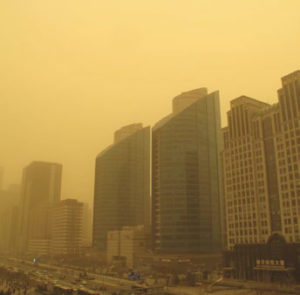
A bad air day in Beijing (original colour).
Photo: Danwei Media
When information perceived as threatening stability circulates on the Chinese Internet, it can be ruthlessly suppressed using the various mechanisms described above. As Gloria Davies has noted in Chapter 5, attempts by anonymous activists in the spring of 2011 to use the Internet to organize ‘Jasmine Movement’ protests in Chinese cities were scrubbed from the domestic Internet, while similar webpages and sites hosted abroad were effectively blocked by the Great Firewall. But in the northern autumn of 2011, a different kind of online activism appeared in China that hinted at ways in which the Internet could possibly develop as a platform for public discussion.
In October and early November 2011, Beijing residents began complaining online about the grave air pollution in the city. They noted the number of consecutive days of poor air quality on which they could quite literally see with their own eyes, and sometimes even taste, the pollution. They showed that it did not tally with claims by the State Environmental Protection Agency (SEPA) about blue-sky days. Nor did crowd-sourced statistics about pollution-haze days match the numbers released by the government. Previously, the simmering resentment might have found no outlet or redress. However, SEPA is no longer the only body tracking air pollution in the capital. Since 2008, an air quality monitor installed on the roof of the US Embassy had been sending out hourly updates on Twitter (user name: @BeijingAir) on air quality. These readings include the measure of PM2.5, a form of fine particulate matter that is considered to be the most dangerous to human health because the tiny particles can enter the lungs as well as other organs, and even the skin. SEPA’s readings did not include PM2.5 measurements.
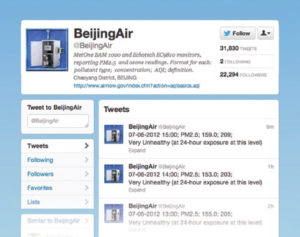
A screenshot of the Twitter feed maintained by the US Embassy in Beijing that sends out hourly air quality measurements.
Source: Twitter.com
Although Twitter is blocked by the Great Firewall, a stream of tweets can easily be fed onto another website that is not blocked or to an iPhone application that doesn’t require the user to visit the inaccessible domain website at Twitter.com. The year 2011 was one in which iPhones became de rigeur for China’s status-conscious urbanites; and many iPhone owners in Beijing downloaded apps that provided them with a constant stream of US Embassy pollution readings. One of these was the real-estate magnate and media figure Pan Shiyi, one half of the husband-wife team behind some of the most grand (and grandiose) commercial building projects in the Chinese capital. Even with his untold wealth, Pan realized he was powerless to stave off the threat of Beijing’s awful air. So in October and November 2011, he began venting his outrage at the city’s air quality online. He declared to his more than eight million microblog followers that the Chinese government should release data for PM2.5 readings. Pan was not alone in this; thousands of other Beijing residents complained about the air via the microblog system and other social media websites and demanded action. In January 2012, in a rare victory for online people power, the official Xinhua News Agency reported that Beijing would start providing PM2.5 data. The air is still foul, but at least people were better informed about how foul it is.
It is obvious from even the cursory survey offered here that China’s Great Firewall is not an hermetically sealed system. Within the Firewall, censors of various kinds work tirelessly (but not always effectively) to adapt to the growing ability of Internet users to say what they think. After years of unfulfilled promise, 2011 truly was a watershed year during which the Internet became the most important platform for public contestation in China and the most influential medium for social and cultural change.


